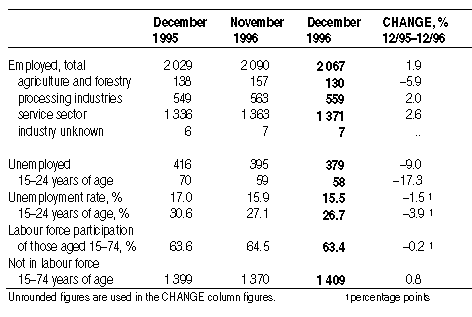23 January 1997
Employment picked up before Christmas
There was an increase in the number of employed by almost 40 000 from December 1995 to December 1996, as indicated by the Labour Force Survey of Statistics Finland. The number of jobs rose in the service sector, mostly in trade and commerce, as well as in processing.
The number of men's jobs increased while the number of women's jobs was at the same level as the year before. Seasonally adjusted employment rose by 5 000 from November to December 1996.
The number of unemployed stood at 379 000 in December 1996, which is 37 000 less than a year ago. The unemployment rate fell in the year by 1.5 percentage points to 15.5 per cent. The unemployment rate of men fell by 3.1 percentage points to 14.7 per cent, whereas that of women rose 0.2 percentage points to 16.4 per cent.
Youth unemployment decreased by over 10 000 in one year, down to 58 000 in December 1996. Seasonally adjusted unemployment fell by 3 000 from November to December 1996.
Changes in the labour force from December 1995 to
December 1996, 1 000 persons

Unrounded figures are used in the CHANGE column figures. 1 percentage points The highest unemployment rate was still in construction, at 23.3 per cent. However, proportionately it also saw the greatest fall, a full 13 percentage points.
The trend in unemployment was still slowly declining in December.
Wide gap between the figures of Statistics Finland and the Ministry of Labour
The data for the Labour Force Survey of Statistics Finland were collected by interviewing about 10 000 Finns of working age. The data relate to the period December 2-8. The Labour Force Survey is a panel survey based on a sample, in which the same person is surveyed five times over a period of eighteen months.
The Labour Force Survey provides data both on employment and unemployment. It is based on the recommendations of the International Labour Organisation (ILO) and it is comparable with the corresponding statistics of other countries.
The Ministry of Labour also publishes statistics on unemployment. The data on unemployed job applicants are from the last working day of the month. Owing to differences in methods and definitions, the unemployment figures of Statistics Finland and the Ministry of Labour are not comparable.
The difference between the unemployment figures of Statistics Finland and the Ministry of Labour were exceptionally high in December, amounting to about 90 000. At the end of the year there were 468 000 unemployed persons in the job-seekers register of the Ministry of Labour.
The wide gap could partly be explained by the seasonal jobs of the Christmas season, by the timing of publicly financed employment contracts and training as well as by the changes in the labour market legislation that entered into force at the beginning of 1997. The changes may have accelerated registrations at the employment offices before the end of 1996, and thus partly increased the unemployment figures of the Ministry of Labour.
When assessing the figures of the Labour Force Survey, the confidence interval, which is due to the standard error of the sample survey, also has to be taken into account. This interval was ± 0.8 percentage points in the unemployment rate in December.
Statistics Finland and the Ministry of Labour have jointly re-examined the differences between the unemployment figures, which will be released at the beginning of March together with the figures of the Labour Force Survey of January.
Employment also improved in the whole year
The unemployment rate of the whole of 1996 was on average 16.3 per cent, which is about one percentage point less than the year before. There were on average 2 096 000 employed persons in 1996, being about 30 000 more than in 1995.
Source: Labour Force Survey, December 1996. Statistics
Finland
Further Information: Tapio Oksanen, tel. +358 9 1734 3228,
Hannu Siitonen, tel. +358 9 1734 3225, and Salme Kiiski, tel. +358
9 1734 3230
